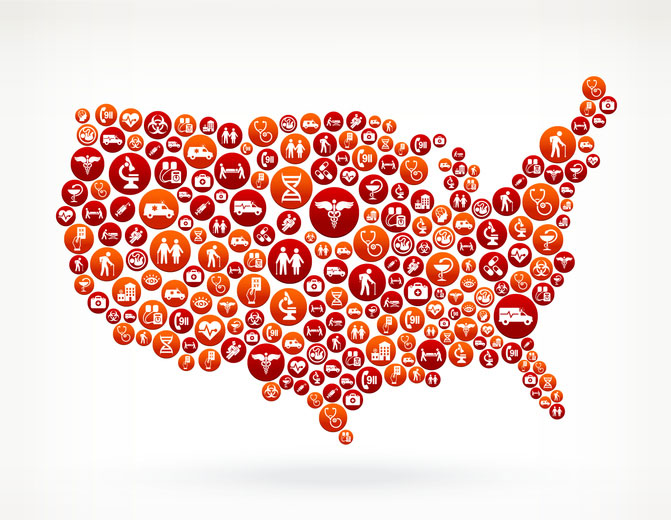How Much Does a Health Administrator Make?
Every day, health administrators face a number of complex and challenging issues. They coordinate between diverse teams of doctors, nurses, and other professionals that offer their patients customized levels of care. But on top of that, they devise marketing strategies, seek out private and government funding, and integrate new services into their organizations’ structures. A health administrator’s duties are, at times, seemingly endless.

Fortunately, the Bureau of Labor Statistics (BLS) reports salaries for health administrators that match their often exhausting workload. In 2021, they found that medical and health services managers make a mean annual salary of $119,840. The top-earning health administrators often see yearly earnings in excess of $205,000.
However, these two numbers paint an incomplete picture of an increasingly dynamic industry. Practice setting, practice size, additional cash incentives, and geographic location can all affect a health administrator’s salary. If you’re planning a career in health administration, here’s how all of those factors might influence your salary potential.
Healthcare Administrator Salaries By Practice Setting
A healthcare administrator’s duties are largely shaped by the type of practice in which they serve. A position at a physician’s office might entail insurance coding and drafting patient care practices while a nursing home administrator may be more focused on ensuring all caregivers have the proper licensing and training. In many cases, these tasks influence salary.
Per the BLS’s May 2021 occupational survey, these are the mean annual salaries offered to health administrators in different practice settings:
Within these industries, health administrators work in clinical and non-clinical roles that sometimes require certain licenses and healthcare-related degrees. Holding such qualifications can increase one’s career opportunities and, in turn, increase salary potential.
Regional Guide to the Salaries Healthcare Executives are Earning
Like with other industries, average health administrator salaries can vary greatly by region. This might be due to population size, opportunities provided by national research labs, and the needs of each specific population. For instance, average salaries in Florida, a state known for its large retired population, might be closer to those of nursing home administrators. Similarly, salaries in the rural Midwest might be influenced by the fact that many hospitals serve many counties.
Fortunately, the BLS breaks down medical and health service administration salaries by state.

Western Region (Including Alaska and Hawaii)
Due to their burgeoning tech industries and large metropolitan areas, many of America’s western states have higher than average mean annual salaries for health administration professionals.
BLS-reported mean annual salaries for health administration professionals in western states:
- Alaska: $123,990
- California: $132,180
- Colorado: $124,190
- Hawaii: $130,930
- Idaho: $105,990
- Montana: $95,670
- Nevada: $108,770
- Oregon: $125,770
- Utah: $108,300
- Washington: $138,580
- Wyoming: $104,500
According to the BLS, Washington is the fourth highest-paying state for healthcare administrators by mean annual salary.
Southwestern Region
Though southwestern states don’t have as many large metro areas as their westerly counterparts, places like Houston, Phoenix, and Dallas host a number of large healthcare networks, clinical labs, and university-based healthcare research initiatives. Los Alamos National Laboratory, a government research institution with a large health and bioscience department, is located in New Mexico.
BLS-reported mean annual salaries for health administration professionals in southwestern states:
- Arizona: $117,420
- New Mexico: $118,670
- Oklahoma: $99,920
- Texas: $116,690
With just over 36,000 health administrators, Texas employs the second-most medical and health services managers in the nation.
Midwestern Region
With generally lower costs-of-living and population densities than the rest of the country, many midwestern states have lower mean wages for health administrators than their regional neighbors. Administrators in these states often oversee hospitals that serve large geographic areas.
BLS-reported mean annual salaries for health administration professionals in midwestern states:
- Illinois: $125,720
- Indiana: $102,790
- Iowa: $97,240
- Kansas: $102,230
- Michigan: $107,820
- Minnesota: $106,950
- Missouri: $108,150
- Nebraska: $112,710
- North Dakota: $134,320
- Ohio: $110,510
- South Dakota: $112,070
- Wisconsin: $119,670
Surprisingly, Montana has the fourth highest concentration of healthcare management jobs in the country with 4.48 out of every 1,000 jobs in the state being within the industry.
Southeastern Region
The southeastern US doesn’t have astoundingly high mean salaries for healthcare administrators, but cities like New Orleans, Nashville, and Atlanta are home to large hospitals, insurance providers, and research institutions. Other unique opportunities in the region can be found in Florida’s senior care communities or in the rural areas surrounding the Appalachian Mountains.
BLS-reported mean annual salaries for health administration professionals in southeastern states:
- Alabama: $94,070
- Arkansas: $92,110
- Florida: $107,850
- Georgia: $109,840
- Kentucky: $104,220
- Louisiana: $104,270
- Mississippi: $94,270
- North Carolina: $121,430
- South Carolina: $112,310
- Tennessee: $111,680
- Virginia: $120,890
- West Virginia: $109,290
Per BLS data, Florida employs the third highest number of health service managers (just under 31,000) while Arkansas has the third highest concentration of health administration jobs in the country (4.66 out of 1,000 jobs in the state economy).
Northeastern Region and New England (Including Washington, DC)
The northeast is dotted with healthcare hotshot headquarters: Johnson and Johnson in New Brunswick, NJ, Pfizer in New York City, and ImmunoGen in Boston to name a few — not to mention all of the national research labs (public and private) found in Washington, DC. Mean health administrator salaries in these states often reflect this dynamic landscape.
BLS-reported mean annual salaries for health administration professionals in northeastern states:
- Connecticut: $126,790
- Delaware: $134,710
- Maine: $102,070
- Massachusetts: $140,270
- Maryland: $135,870
- New Hampshire: $126,700
- New Jersey: $136,580
- New York: $155,430
- Pennsylvania: $118,380
- Rhode Island: $132,080
- Vermont: $116,600
- Washington, DC: $151,370
According to the BLS, four out of the five top-paying states for health management professionals are in this region: New York, Washington, DC, Massachusetts, and New Jersey. Likewise three of the five states with the highest concentrations of medical management employment are Massachusetts (number one in the nation), Connecticut, and Maryland.
What Healthcare Administrators in the Nation’s Biggest Metro Areas are Earning
It’s no coincidence that some of the country’s most populated metro areas have higher-than-average health administration salaries. In some cities, hospitals have enough staff and patients to fill entire towns. Other cities host research institutions and pharmaceutical headquarters that handle billions of dollars every year. And it’s up to administrators to bring it all together.
In order, here are the five top-paying metropolitan areas for health care administrators per BLS data:
- San Jose-Sunnyvale-Santa Clara, CA
- Annual mean wage: $162,110
- Notable healthcare employers: Intuitive Surgical (manufacturing), Lucille Packard Children’s Hospital, VA Palo Alto Health Care
- Vallejo-Fairfield, CA
- Annual mean wage: $157,340
- Notable healthcare employers: California Medical Facility (prison), Northbay Healthcare, Vacaville Medical Center
- New York-Newark-Jersey City, NY-NJ-PA
- Annual mean wage: $156,370
- Notable healthcare employers: Pfizer, Mount Sinai Health System, Travelers Insurance
- California-Lexington Park, MD
- Annual mean wage: $150,900
- Notable healthcare employers: Quest Diagnostics, the US Navy, Medstar St. Mary’s Hospital
- San Francisco-Oakland-Hayward, CA
- Annual mean wage: $150,250
- Notable healthcare employers: Alameda Health Systems, Genentech (biotechnology research), Grifols Diagnostic Solutions (pharmaceutical research labs)
Even though 30% of medical services managers work in are hospital administrators, the diverse employers in these major cities illustrate one thing: healthcare administrators have a place in every sector of the American healthcare industry. And in some places, they demand high salaries for their organizational talents.
Health Administration Salaries in Metro Areas Across the Nation
While the top-paying metros offer their own unique health administration career opportunities, many more can be found in cities and metros from coast to coast. In many cases, these roles can draw triple-figure salaries exceeding statewide medians for similar occupations.
According to the BLS, here’s what health administrators are earning (mean annual wage) in select metro areas in all 50 states:
- Montgomery, Alabama: $93,020
- Anchorage, Alaska: $120,270
- Phoenix (includes Mesa, Scottsdale), Arizona: $118,390
- Little Rock (includes North Little Rock, Conway), Arkansas: $97,940
- Los Angeles (includes Long Beach, Anaheim), California: $122,960
- Denver (includes Aurora, Lakewood), Colorado: $135,560
- Bridgeport (includes Stamford, Norwalk), Connecticut: $134,380
- Wilmington (includes Philadelphia, PA and Camden, NJ), Delaware: $127,840
- District of Columbia (includes Arlington, Alexandria): $140,860
- Jacksonville, Florida: $111,660
- Atlanta (includes Sandy Springs, Roswell), Georgia: $118,790
- Honolulu, Hawaii: $133,690
- Boise, Idaho: $111,480
- Chicago (includes Naperville, Elgin), Illinois: $130,450
- Indianapolis (includes Carmel, Anderson), Indiana: $108,020
- Des Moines, Iowa: $98,800
- Wichita, Kansas: $97,780
- Louisville, Kentucky: $118,470
- New Orleans (includes Metairie), Louisiana: $119,180
- Portland (includes South Portland), Maine: $107,570
- Baltimore (includes Columbia, Townson), Maryland: $134,530
- Boston (includes Cambridge, Nashua, NH), Massachusetts: $146,490
- Detroit, Michigan: $112,370
- Minneapolis (includes St. Paul, Bloomington), Minnesota: $113,590
- Jackson, Mississippi: $103,910
- Kansas City, Missouri: $111,880
- Billings, Montana: $105,070
- Omaha (includes Council Bluffs, IA), Nebraska: $118,390
- Las Vegas (includes Henderson, Paradise), Nevada: $107,030
- Manchester, New Hampshire: $134,600
- Trenton, New Jersey: $127,560
- Albuquerque, New Mexico: $125,470
- Buffalo (includes Cheektowaga and Niagara Falls), New York: $133,280
- Charlotte (includes Concord, Gastonia), North Carolina: $124,170
- Fargo, North Dakota: $136,040
- Columbus, Ohio: $111,850
- Oklahoma City, Oklahoma: $103,080
- Portland (includes Vancouver, WA, and Hillsboro, OR), Oregon: $137,410
- Philadelphia (includes Camden, NJ and Wilmington, DE), Pennsylvania: $127,840
- Providence (includes Warwick, MA), Rhode Island: $128,700
- Charleston (includes North Charleston), South Carolina: $114,040
- Sioux Falls, South Dakota: $125,320
- Nashville (includes Davidson, Murfreesboro, Franklin), Tennessee: $119,200
- Houston (includes the Woodlands, Sugar Land), Texas: $120,300
- Salt Lake City, Utah: $117,580
- Burlington (includes South Burlington), Vermont: $112,930
- Virginia Beach (includes Norfolk, Newport News), Virginia: $111,740
- Seattle (includes Tacoma, Bellevue), Washington: $147,610
- Charleston, West Virginia: $127,850
- Milwaukee (includes Waukesha, West Allis), Wisconsin: $126,430
- Cheyenne, Wyoming: $101,370
Facility Size Has More to Do with What Healthcare Executives Earn Than Almost Any Other Single Factor
Outside of practice area and geographic location, healthcare executive salaries are heavily influenced by the sizes of the organizations they serve. Like in other industries, larger employers in healthcare typically have more resources to devote to talent acquisition — including offering high base pay.

In August 2022, industry-leading news magazine Modern Healthcare published their annual Executive Compensation Survey. Informed by data from over 2,000 health systems across the nation, this survey lists the median base salaries for different types of executives at healthcare organizations of multiple sizes.
Hospitals with Net Revenue Less Than $300 Million
Hospitals with Net Revenue More Than $300 Million
Healthcare Provider Systems with Net Revenue Less Than $1 Billion
Healthcare Provider Systems with Net Revenue of $1 – $3 Billion
Healthcare Provider Systems with Net Revenue of $3 Billion or More
Executive Compensation Survey Data for Select Administrative Roles
Many of the roles listed in the Executive Compensation Survey are top-level positions administrators obtain after years in the industry. However, the survey also includes salary information for more specific departmental leadership positions.
According to the survey, these are the median base salaries for different types of healthcare administrators:
- Fund development executive: $281,100
- Human resources administrator: $233,700
- Medical informatics executive: $399,400
- Compliance officer: $301,300
- Risk management executive: $300,300
- Chief technology officer: $302,600
Some of these roles might require pursuing more education. For instance, technology officers might need degrees or certificates in IT management. Compliance officers may need some sort of state license to stay up-to-date on all current regulations. But with a degree in health administration, professionals could have a great base of knowledge to build upon.
Total Cash Compensation for Healthcare Executives
As the Executive Compensation Survey indicates, compensation for many healthcare executives doesn’t end with base pay. Bonuses can add hundreds of thousands of dollars to an executive’s yearly earnings. But how do healthcare executives actually get these cash incentives?

Healthcare executives often get bonuses for:
So in a sense, healthcare administration is a field that often directly rewards talent and hard work. In fact, Modern Healthcare’s survey reports that between 2021 and 2022, executives in charge of three or more support or clinical departments saw median pay increases of 21%.
If you’re ready to help healthcare organizations of all kinds meet new financial goals, serve more patients, and develop groundbreaking procedures, tools, and medicines, find out how earning a bachelor’s or Master’s in Health Administration can put you on that path. In a world where healthcare is becoming an increasingly global issue, there’s never been a better time to become one of the industry’s organizational architects.
2021 US Bureau of Labor Statistics salary and employment figures for medical and health services managers reflect national data, not school-specific information. Conditions in your area may vary. Data accessed January 2023.
error:SSL certificate problem: unable to get local issuer certificate






